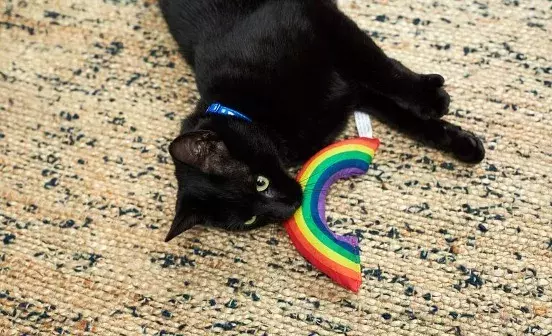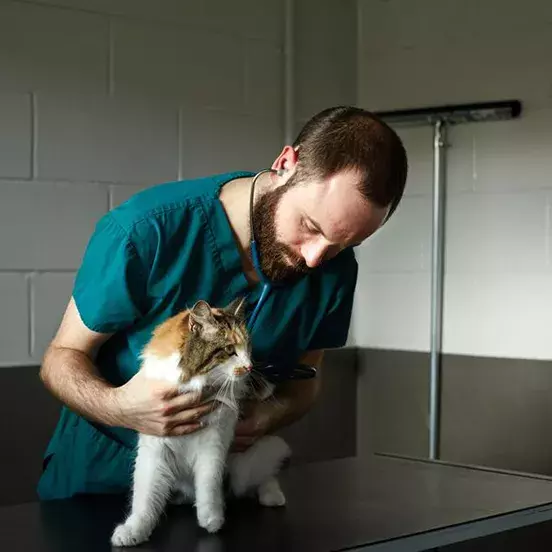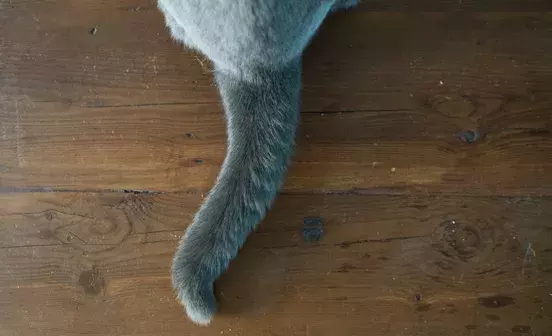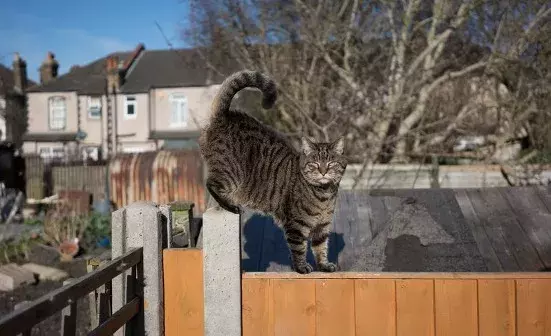Cats can be very sensitive creatures and may often become anxious or frustrated by things going on around them, or by the way people interact with them. Here is our advice on how to help your stressed cat.
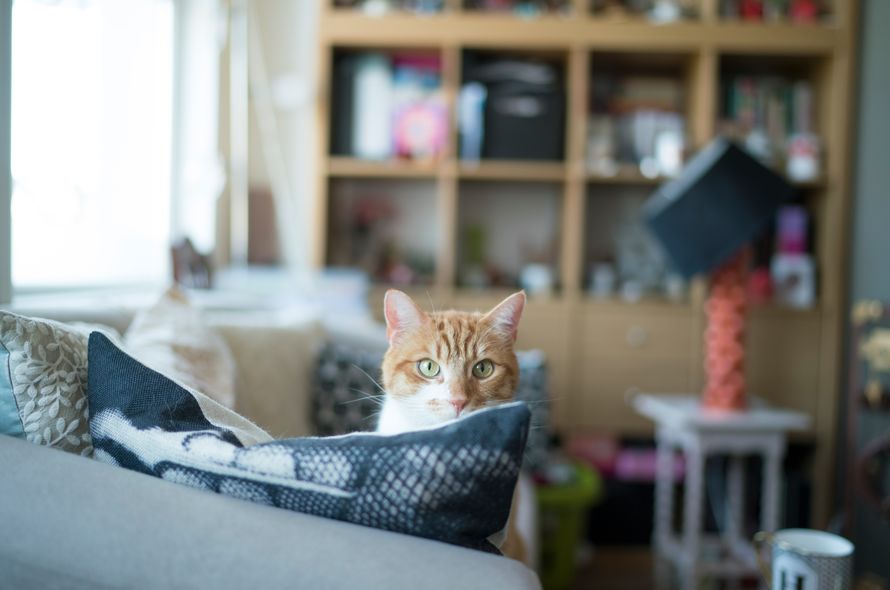
Evolving from a largely independent and solitary species (called the African or Near Eastern wildcat), the domestic cat can be very good at hiding signs that they are stressed or in pain, because in the wild this would make them an easier target for predators.
It is important that you manage and reduce stress in your cat as much as you can because if your cat is stressed, they can become both emotionally and physically unwell and may develop physical illnesses as well as display problem behaviour. Often owners may only notice something is ‘not quite right’ with their cats when they have already been stressed for some time. Cats may lose their appetite or be sick occasionally or behave in a way that owners have never seen before, such as spraying urine against the wall indoors or behaving aggressively.
The sooner you realise that your cat could be experiencing stress, the sooner you can resolve the problem. This means you need to keep a close eye on your cat’s physical health as well as their behaviour so that anything ‘odd’ or ‘out of character’ that could be a sign of stress is quickly identified.
SIGNS OF STRESS IN CATS
There are some common signs of a stressed cat, both physical and behavioural.
PHYSICAL SYMPTOMS
- Diarrhoea
- Vomiting
- Large bald patches or sores on the coat caused by over grooming
- Runny nose and eyes (e.g. cat ‘flu’)
- Symptoms get worse in cats with chronic health conditions or recovery from illness is slow (stress can affect a cat’s immune system and ability to fight disease)
- Eating non-food items such as plastic or wool (this is called ‘pica’)
- Poor appetite or eating less than normal
- Looking lethargic and sleeping more than usual
- Excessive eating and/or drinking
- Sudden weight loss or weight gain
- A poor coat condition
- Not going to the toilet as often as usual (faeces and/or urine)
- Frequent squatting, painful urination with blood in it (e.g. cystitis)
BEHAVIOURAL SYMPTOMS
- Any noticeable change in your cat’s usual patterns of behaviour and routines
- Toileting outside of the litter tray (e.g. behind the sofa, under the bed, on the bed etc.)
- Spraying urine on furniture and other items around the home
- Scratching excessively on the furniture
- Aggressive behaviour directed towards you, your family or visitors
- Aggressive behaviour directed towards other pets in the home
- Excessive meowing
- An increased dependency on you or your family, constantly wanting to interact
- Withdrawal from you and the family, no longer interested in interacting with you
- Unresponsiveness to things going on around them (they don't jump or get startled by loud noises or quick movements)
- Constant vigilance and jumps at every sudden sound or movement
- Frequent hiding when in the home (e.g. under a sofa or bed, on top of a wardrobe)
- Reluctance to play – having previously been very playful
- Reluctance to come into the home
- Reluctance to go outside
- Excessive grooming
- Repeated pacing when in the home, often accompanied by loud meowing
OTHER SIGNS OF A STRESSED CAT
You may notice your cat sits differently, their facial expression changes or they exhibit strange behaviours.
- Often crouching and looking tense indoors
- Ears rotate backwards frequently or flatten downwards
- Wide open eyes with very dilated pupils which makes their eyes look black
- Staring at the floor with a fixed, glazed expression
- Rapid frequent grooming that usually lasts around five seconds, starting and stopping quite suddenly
- Frequent head shaking
- Rippling, twitching skin on their back
- Exaggerated swallowing and quick flicks of their tongue onto their nose
One of the best ways to protect your cat against possible stress is to try to anticipate the sorts of things that might cause them stress in the first place (such as moving to a new home or the addition of a new cat to the household). Once you have identified possible sources of stress, you can then manage the situation or environment in a way that helps reduce the chances of your cat suffering.
WHAT CAN CAUSE MY CAT STRESS AND HOW CAN I REDUCE THIS?
Every cat is an individual. Whilst some cats may generally appear very laid-back and seemingly ‘unflappable’, other cats can be much more sensitive and find many things around them stressful.
The following are common examples of situations that may be stressful for cats:
SOURCES OF STRESS
There are several key resources (things your cat needs) that they will depend on to keep them happy and healthy. If your cat is not provided with them, this can be a great source of stress.
As well as the amount of resources you provide for your cat, the quality, type and location of the resources are also incredibly important. For example, if the litter tray you provide for your cat is too small, not cleaned out regularly enough or is placed next to a noisy area in the home or next to their food and water bowls, these factors can all cause stress.
Whether you have just rehomed your cat and they are being introduced to your home for the first time, or you are moving home with your existing cat, this can be a very stressful time for them.
Cats like to be in a familiar environment as this helps them feel safe and secure. If they suddenly find themselves in a place they have never been before, this can cause them to feel anxious or worried.
Ensuring your cat has all the resources they need and then introducing them to a new environment gradually and carefully are key to reducing stress.
If you are moving home and you know your cat is likely to become stressed by all the disturbance and commotion this may bring, it may be better for them to stay with a friend or in a good cattery during this period. Your cat can then be introduced gradually to the new home once the move is complete.
The arrival and presence of other cats or dogs in the home can be very stressful for a cat – whether this is from the perspective of a new cat to the home being introduced to an existing cat already resident in the home or from the perspective of the resident cat trying to cope with the arrival of an unfamiliar cat in their home.
For the new cat, this can be a particularly stressful time as they are being introduced to an unfamiliar home, new people and other pets all at the same time which is likely to make even the boldest and most confident cat feel worried and unsettled.
For the resident cat, as well as the stress associated with the sudden presence of an unfamiliar cat in to their home (often referred to as a cat’s ‘core territory’), there are likely to be other general changes associated with the addition of a new cat that might also cause your cat stress (such as a change in your behaviour, changes in routines, changes to access around the home etc.). It’s therefore important to try to maintain a resident cat’s normal routines as much as possible, and if you need to move any of her resources to accommodate the arrival of a new cat, that you do this gradually and before the new cat arrives.
Unlike dogs, as cats have evolved from a mainly solitary species, they may see the presence of another cat in the home as a possible ‘threat’. It’s therefore really important that you introduce the cats carefully and gradually and that you manage their environment, resources and relationship over the long term so they can live together harmoniously in the home.
Just like with a new cat, when it comes to introducing your new cat to a resident dog, the key here is again to introduce them carefully and slowly so that the cat has a better chance of feeling safe and in control in the presence of the dog.
For a cat, sharing their important resources (such as food, litter trays, beds, human attention etc.) with another cat, especially if they haven’t grown up together, can be really stressful.
Cats can often see other members of their species as ‘competitors’ rather than ‘allies’. Signs of tension between cats can be quite subtle and so owners can easily not pick up on them.
Owners need to provide, and carefully place, all their key resources to help reduce tension and conflict between cats and encourage them to live together happily.
This can be a frequent problem for many cats and may not always happen when you are around to witness it. For example, many intruder cats may come in to the home via the cat flap (or even an open window) late at night or in the early hours of the morning when you are probably in bed.
Unfamiliar cats coming into the home (whether you encourage them to come in or not) can be very stressful for your cat, because they may feel as though they have to be constantly on the look-out, ready to defend their core territory at any minute. Especially if intruder cats are not vaccinated, they may also spread disease to your cat when they come into your home.
The best way to manage this problem is to ensure you feed your cat far away from the cat flap (so that intruder cats are not enticed by the smell of nearby food) and to invest in a microchip-operated cat flap, so that only cats with the correct corresponding microchip (this is the identification microchip that is implanted under the skin on your cat’s neck) can access the cat flap.
Whilst many cats like to be fussed and stroked for long periods of time, no two cats are the same, and some cats may find too much stroking, or being stroked in certain places, uncomfortable and stressful.
Some cats may be very quick to tell you what they like (by meowing for more or pawing at you when you stop stroking them) and what they dislike (by swiping at you or biting you), but others may be much subtler in communicating how they feel. Many cats may simply tolerate being stroked or handled even though they are not enjoying it, and often it is these cats that are becoming the most stressed from the handling they experience.
Pay close attention to your cat’s behaviour and body language when you are stroking them to help you to better understand where and for how long your cat likes being touched.
It is really important that your cat always has the option to remove themselves from the interaction if they choose. This means you should never physically restrain your cat when you are stroking them, or pet them when they are trapped within a hiding space. This will help them to feel more relaxed and in control when they interact with you.
As cats have evolved as an independent solitary species, being able to make their own decisions is important to cats so giving them choice and control over what they do, how, when, and with who is key to reducing stress for your cat.
- Depending on how much noise and disturbance this may bring to the home, and how sensitive your cat is, it may be better for your cat to stay with a friend or in a good cattery during this period.
If the disturbance in the home is likely to be minimal or can be restricted to certain rooms, parts of the home or times of the day, your cat may be able to remain in the home, but will benefit from the following:
- If the building works require you to move any of your cat’s resources (e.g. their food and water) from their usual positions, ensure they are placed in new locations that are quiet and undisturbed and that you move them gradually over a period of time so that your cat has time to get used to these new positions in advance of the sudden noise and disturbance the building work will bring.
- Make sure your cat always has somewhere to escape to or hide away, preferably several different options. Ledges and shelves at different heights and cardboard boxes are ideal.
- If possible, make sure there is still a quiet undisturbed room in the home (complete with options of places for your cat to hide) where your cat can go during noisy busy periods.
- You can also use a Feliway® plug-in diffuser containing a synthetic feline facial pheromone that continuously releases calming pheromones into the environment. This may help to relax your cat and reduce their anxiety.
- If your cat has access to a garden, this offers them another opportunity to escape if they feel overwhelmed by the noise and commotion going on in the home. Making your garden as ‘cat friendly’ as possible can also help your cat to relax whilst they are outside.
Cats feel safe when they are surrounded by familiar things. If you’re changing your sofa then plan ahead and cover the old sofa with a fabric throw before you make the switch and then you can use the same throw (which will smell familiar to your cat) over the new sofa when it arrives.
Cats can be very sensitive to any changes in their owner’s routines, for example, if they start getting up earlier in the mornings or spending more time away from home. Unpredictability can be quite stressful for cats so, if your routines change, try to keep your interactions with your cat as consistent and predictable as possible, for example, making sure you still feed them at the same time and play and interact with them in the same way.
- If you start being away from the home for longer than usual, it’s a good idea to make sure you have provided your cat with an enriched and exciting indoor and outdoor environment to help keep them stimulated and prevent boredom and frustration.
- On the other hand, if you are in the home more than normal, it’s also good to ensure that there is a quiet undisturbed room your cat can retreat to when they need some time alone to relax.
Not only do cats feel safe when they are surrounded by familiar things, they like their home and routines to be predictable and consistent as this helps them to feel more in control of their environment.
Very friendly and bold cats may see visitors as something pleasurable and exciting whilst more nervous or sensitive cats may become worried by the presence of unfamiliar people in the home.
Ensuring your cat always has the means to escape and hide or get up high will help to make them feel safer in these situations. If your cat is sensitive or shy then it may be helpful to follow these guidelines:
- It is a good idea if you let your guests know if your cat is likely to find new people a bit overwhelming and suggest that they let the cat choose whether to approach them or not. Your cat may prefer to have a good look first before they choose to interact. Sometimes it is better for your guests to ignore them and let the cat make the first move!
- If your cat is motivated by food treats, ask your guests to gently throw some of your cat’s favourite treats on the ground a short distance away from them, encouraging your cat to approach.
- If your cat does approach, advise your guests to initially crouch down and offer their hand (palm facing down) for the cat to sniff. If your cat sniffs or rubs against their hand you can encourage your guests to gently stroke the area around your cat’s cheeks and chin. If your cat is very playful, you could also encourage your guests to use a fishing rod or feathered wand toy if you think they would be more comfortable playing than being stroked.
- Whilst your guests visit you can also use the pheromone plug-in diffuser (as mentioned above) to help them feel more relaxed.
The addition of a new baby into the home is a very exciting time but, from your cat’s perspective, it can also cause a lot of disruption in the form of new sounds and smells, changes in your routine, moving of furniture and the arrival of new objects (such as toys, prams and cots).
For some confident and inquisitive cats, this can be very interesting and intriguing, but for others it can cause them stress and anxiety as they may not feel as ‘in control’ of their environment anymore, with so much change happening at once.
- Your daily routine will probably change quite drastically when the baby arrives. If you can anticipate what is likely to change (e.g. how long for, when you play and interact with your cat, who will be feeding your cat, when they will get fed, when they will or won’t have access to certain parts of the home or outdoors etc.) and slowly introduce these changes in advance of baby arriving – this can greatly help your cat to adapt.
- You can gradually introduce your cat to the new objects associated with the baby, for example toys and prams, so that by the time the baby arrives these things are already familiar to your cat. Each time you introduce a new item into the home, place it in a ‘neutral’ area (that means not directly near your cat’s important resources such as food bowls or litter trays), leave some of your cat’s favourite treats on or around the new item, and then let your cat explore it in their own time.
- You can also play your cat recordings (which are commercially available) of the various sounds babies make (giggling, crying, gurgling, squealing) very quietly at first, gently increasing the volume over time so that your cat can slowly and gradually get used to these different noises before the baby arrives. Each time you play the recordings, you can also distract/reward your cat with a few treats.
- As your child starts crawling and then walking, it’s a great idea to provide your cat with lots of places where they can rest and perch that are out of the reach of children, for example, a big ‘cat tree’ or a cat bed placed on a shelf or on top of a cupboard. Using baby gates so that your cat can access an area that is quiet and ‘child free’ is also a great way to help your cat to cope sharing a home with a curious and active young child. As your child starts to show an interest and wants to interact with your cat, you can also teach them how to do this appropriately, such as how and where to touch the cat. By doing this you will help to prevent your child from being bitten or scratched, but also ensure that your cat is comfortable with being stroked.
As cats have evolved as independent solitary hunters responsible for their own survival, feeling safe is essential to cats so having lots of options and choices of places to hide (e.g. igloo type beds, cardboard boxes etc.) or get up high (e.g. on tops of wardrobes, cupboards, shelves etc.) to help them feel secure is one of the key things that you can do to help ensure your cat is happy.
Not only can intruder cats attempting to come into your home be stressful for your cat, but their presence outside and especially in your garden or outside space can also be a source of stress.
The best thing you can do is to make your garden as safe and cat friendly for your cat as possible so that they feel more confident when outside and also ensuring there are plenty of resources (such as rain water for drinking, places to sleep, hide, get up high, as well as places to toilet) that are well distributed to reduce potential conflict between cats.
Especially when there are unneutered female cats in the neighbourhood, entire stray male cats may be attracted to a particular area and can be very vocal, confrontational and aggressive towards other cats. Just having these cats around could be very stressful for your cat.
Unneutered male cats are also more likely to carry various diseases, such as FIV (Feline Immunodeficiency Virus), which could be transmitted to your cat through fighting. The best way to deal with this problem is to talk to your local rehoming charity for advice as they may be able to provide help (or direct you to other organisations that can help) by using a humane trap to capture the cat and either neuter the cat and return them to the same area or relocate the cat to a more suitable environment.
WHAT ELSE SHOULD I DO?
A VISIT TO THE VETS
Whilst there are lots of things you can do at home to help manage and reduce stress in your cat, it is also advisable that you take your cat to a vet to be checked over, especially if you have detected a problem with your cat’s physical health, for example weight loss or signs of cystitis.
SEEKING PROFESSIONAL BEHAVIOURAL ADVICE
In addition to all the advice provided here, it is also recommended that you consult a suitably qualified cat behaviour specialist who will be able to provide more detailed advice specific and tailored to your cat and situation.
Professional behaviour specialists (also known as pet behaviour counsellors) can only work with you if you are referred to them by your vet so speak to your vet first as they may be able to recommend someone straight away or suggest that you contact someone of your choice before arranging the referral.
Behaviour specialists have to go through a rigorous assessment process to achieve formal qualifications or certification, to ensure the advice and support they provide is of the highest standard.
Certain pet insurance companies may also help cover the costs of behavioural consultations from pet behaviour counsellors registered with any of the organisations below. Please visit their websites for more information and help in selecting a suitable person:
